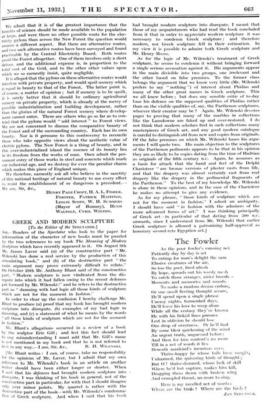GREEK AND MODERN SCULPTURE [To the Editor of the SPECTATOR.]
SIR,—Readers of the Spectator who look to the paper for information of the character of new books must be puzzled by the two references to my book The Meaning of Modern Sculpture which have recently appeared in it. On August 9th Mr. James Laver said (a) of the constructive part " Mr. Wilenski has done a real service by the production of this stimulating book," and (b) of the destructive part the main argument may prove extremely difficult to refute." On October 29th Mr. Anthony Blunt said of the constructive Part, " Modern sculpture is now vindicated from the dis- repute into which it had fallen owing to the recent defences put forward by Mr. Wilenski :" and he refers to the destructive part as " damning with bad logic all those kinds of sculpture which are not 'for the moment in fashion."
In order to clear up the confusion I hereby challenge Mr. Blunt to produce (a) proof that raj, book has brought modern sculpture into disrepute, (b) examples of my bad logic in damning, and (c) a statement of what he means by the words " all those kinds of sculpture which are not for the moment in fashion."
Mr. Blunt's allegations occurred in a review of a book by the sculptor Eric Gill ; and lest this fact should lead to any misunderstanding I must add that Mr. Gill's name is not mentioned in my book and that he is not referred to [Mr. Blunt writes : I can, of course, take no responsibility for the opinions of Mr. Laver, but I admit that my own reference to Mr. Wilenski's book in an article on another writer should have been either longer or shorter. When I said that his defences had brought modern sculpture into disrepute, I was thinking of his book in general, not of the constructive part in particular, for with that I should disagree only over minor points. My quarrel is rather with the destructive part of the book—with Mr. Wilenski's condemna- lion of Greek sculpture. And when I said that his book
had brought modern sculpture into disrepute, I meant that those of my acquaintances who had read the book concluded from it that in order to appreciate modern sculpture it was necessary to condemn Greek sculpture ; and therefore modern, not Greek sculpture fell in their estimation. In my view it is possible to admire both Greek sculpture and Mr. Henry Moore.
As for the logic of Mr. Wilenski's treatment of Greek sculpture, he seems to condemn it without bringing forward a single serious accusation against it. His arguments appear in the main divisible into two groups, one irrelevant and the other based on false premises. To the former class belongs the argument that we know very little (Mr. Wilenski prefers to say " nothing ") of interest about Phidias and many of the other great names in Greek sculpture. This we all knew before ; but does any sensible critic of to-day base his defence on the supposed qualities of Phidias rather than on the visible qualities of, say, the Parthenon sculptures, whoever their creator may be ? Again, Mr. Wilenski devotes pages to proving that many of the marbles in collections like the Lansdowne are faked up and over-restored. I do not think that modern scholars find in such collections many masterpieces of Greek art, and any good modern catalogue is careful to distinguish old from new and copies from originals. Of the false premises on which Mr. Wilenski bases his argu- ments I will quote two. His main objection to the sculptures of the Parthenon pediments appears to be that in his opinion they are as likely to be copies dating from the time of Hadrian as originals of the fifth century ac. Again, he assumes as a basis for attack that the hand and feet of the Delphi Charioteer " are bronze versions of plaster casts from life, and that the drapery was almost certainly cast from real drapery like the drapery in the pedimental fragments of the Parthenon." To the best of my knowledge Mr. Wilenski is alone in these opinions, and in the case of the Charioteer he makes no attempt to give any evidence.
As for my phrase, " those kinds of sculpture which arc not for the moment in fashion," I admit an ambiguity. I should have said " in fashion with the admirers of the more advanced forms of art." I was thinking principally of Greek art—in particular of that dating from 500 n.e. onwards, since I understand from Mr. Wilenski that earlier Greek sculpture is allowed a patronizing half-approval as honorary second-rate Egyptian art.]






























 Previous page
Previous page